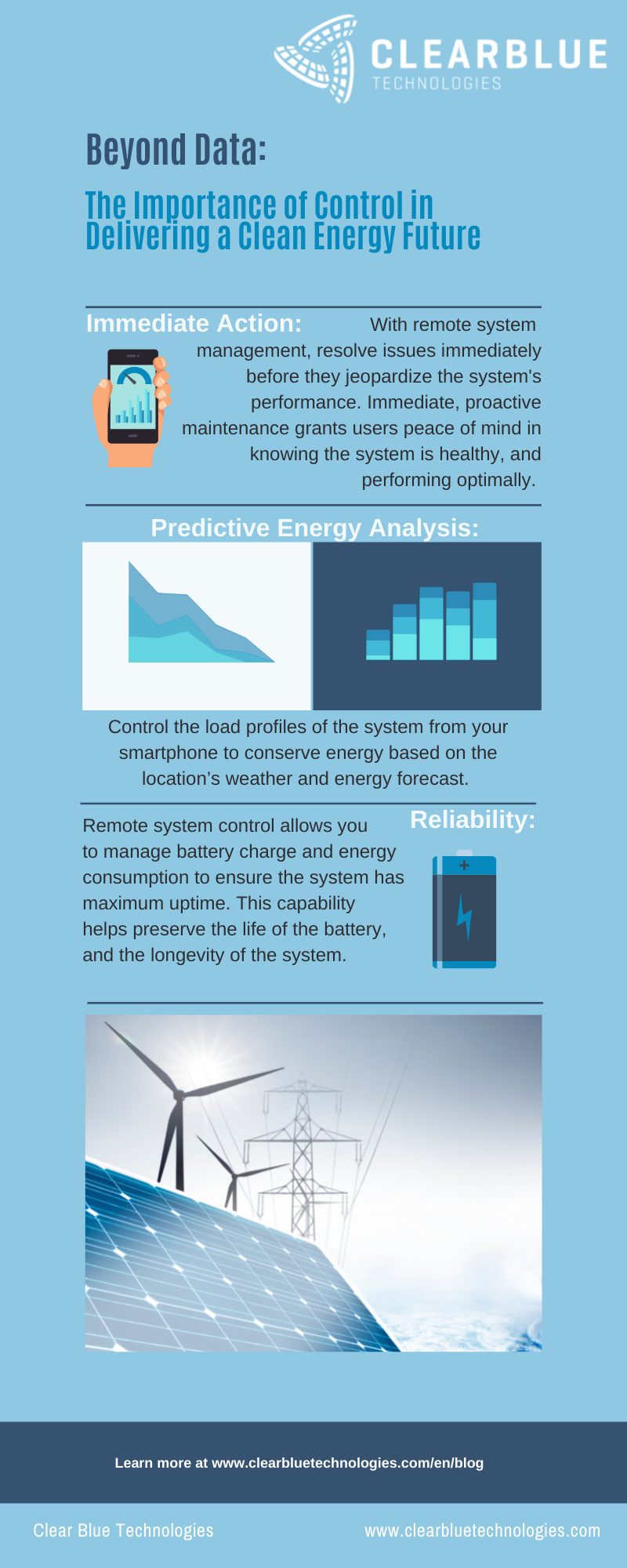Beyond Data: The Importance of Control in Delivering a Clean Energy Future

Renewable energy technologies have gained significant ground in recent years, and green energy investment continues to trend upward. Much of this progress results from the shift to the cloud, where companies can store large swathes of data in a secure location and constantly monitor the status of their systems. However, a few obstacles continue to inhibit the proliferation of renewable energy sources. Specifically, questions may remain about the reliability of clean energy sources such as solar and wind, as well as the potential costs of shifting to these technologies. Through remote management and control provided by Smart Off-Grid systems, renewable energy sources can be made both extremely reliable and cost-effective. Let’s examine the difference between monitoring and control and see how expert management and control can help make clean energy scalable.
Monitoring: A Step Toward Intelligent Energy Systems
With off-grid systems, the ability to monitor the status of your systems is undoubtedly important. Through the cloud, off-grid systems can store data going back to the time of installation. This allows teams to diagnose issues quickly and accurately because they have a vast knowledge base to pull from. System monitoring can provide access to numerous customizable reports about load profiles and energy generation and consumption. This feature arms the team with the requisite knowledge to make informed decisions about the system, and the continuous accumulation of data allows the system to “smarten up.” System monitoring provides customers with alerts about the status of the site’s loads, batteries and solar panels, which is critical information for troubleshooting.
So close, yet so far.
Although highly valuable, the ability to monitor your off-grid power systems is only influential if it's used to take swift and proactive action towards ensuring maximum uptime. Only through remote system control can we cash in on the full power of data and monitoring. In this way, cloud-based power management and control is the secret sauce of Smart Off-Grid systems that makes the material difference – here’s why:
Management/Control: Taking Smart to a New Level
What if, when a potential problem is discovered, we could deal with it in the cloud prior to it becoming an issue or deal with it immediately and avoid the need to send a team of technicians to the site? This is the real difference that Smart Off-Grid makes. When the service team monitoring the site sees an issue, it can take immediate action to ensure that the issue does not jeopardize the system's total performance. This is done without having to go to the site.
For instance, if a low solar energy generation period is forecasted through predictive weather and energy analysis, remote management is critical. It allows the team to immediately control load profiles (adjust light intensity, time of day, or enable motion detection) to conserve energy and maximize uptime. By this, remote system management through Smart Off-Grid technology provides reliable power by securing the uptime and performance of the system. In addition, Smart Off-Grid’s remote control prevents unnecessary trips to the site, which are often required even if the system is being remotely monitored. Instead, it allows maintenance to be done proactively and remotely, which leads to crucial cost savings, especially in cases where sites are remote and not easily accessible.
Example in Action: Low Voltage Disconnect
Let’s take low voltage disconnect (LVD), for example, to see how remote management allows Smart Off-Grid systems to go the extra mile. In both lead-acid and lithium-ion batteries, there are specific thresholds at which further discharging or charging can harm the battery and reduce its life. With system monitoring, users are alerted when the battery voltage is approaching the LVD. However, this knowledge only makes a material difference if you can control and adjust the battery’s charging cycles to solve the problem.
Typically, there is an eight-to-twelve-hour power consumption period after the alert before the system reaches the LVD threshold. Without remote system management, a technician would have to be sent to the site to resolve the issue, or the system would enter LVD and begin to damage the battery. At best, a costly service visit would be needed to prevent the system from entering LVD. At worst, the battery may enter LVD before the proper maintenance can be done, inhibiting future performance.
The Difference Maker:
Remote system management avoids both of these scenarios by facilitating immediate action. As a result, it is more cost-effective, enhances reliability, and ensures optimal performance and uptime. Therefore, the capacity to remotely manage the system provides substantial advantages. System data and monitoring are essential but only translate to tangible benefits (cost savings and improved reliability) when the system can be remotely controlled.
The Solution: Ensuring You Have SMART Off-Grid Power Systems
Ultimately, remote management and control is the leading edge of renewable energy technology. The ability to control the performance of your system anytime or anyplace brings intelligence to your power enabling you to improve system uptime and save money on maintenance trips to the site. Furthermore, by maintaining the battery life, advanced remote control protects the overall performance of the system. Finally, by making batteries last longer, renewable energy technologies will become cheaper, thereby contributing to the adoption and proliferation of renewable energy sources. The tangible, unique benefits provided by remote management through Smart Off-Grid Power give it an X factor needed to make renewable energy scalable and the top choice for power moving forward.

